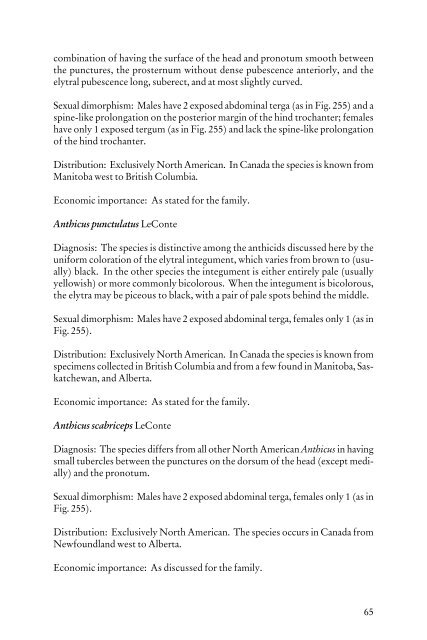Beetles Identification Guide
Beetles Identification Guide
Beetles Identification Guide
Create successful ePaper yourself
Turn your PDF publications into a flip-book with our unique Google optimized e-Paper software.
combination of having the surface of the head and pronotum smooth between<br />
the punctures, the prosternum without dense pubescence anteriorly, and the<br />
elytral pubescence long, suberect, and at most slightly curved.<br />
Sexual dimorphism: Males have 2 exposed abdominal terga (as in Fig. 255) and a<br />
spine-like prolongation on the posterior margin of the hind trochanter; females<br />
have only 1 exposed tergum (as in Fig. 255) and lack the spine-like prolongation<br />
of the hind trochanter.<br />
Distribution: Exclusively North American. In Canada the species is known from<br />
Manitoba west to British Columbia.<br />
Economic importance: As stated for the family.<br />
Anthicus punctulatus LeConte<br />
Diagnosis: The species is distinctive among the anthicids discussed here by the<br />
uniform coloration of the elytral integument, which varies from brown to (usually)<br />
black. In the other species the integument is either entirely pale (usually<br />
yellowish) or more commonly bicolorous. When the integument is bicolorous,<br />
the elytra may be piceous to black, with a pair of pale spots behind the middle.<br />
Sexual dimorphism: Males have 2 exposed abdominal terga, females only 1 (as in<br />
Fig. 255).<br />
Distribution: Exclusively North American. In Canada the species is known from<br />
specimens collected in British Columbia and from a few found in Manitoba, Saskatchewan,<br />
and Alberta.<br />
Economic importance: As stated for the family.<br />
Anthicus scabriceps LeConte<br />
Diagnosis: The species differs from all other North American Anthicus in having<br />
small tubercles between the punctures on the dorsum of the head (except medially)<br />
and the pronotum.<br />
Sexual dimorphism: Males have 2 exposed abdominal terga, females only 1 (as in<br />
Fig. 255).<br />
Distribution: Exclusively North American. The species occurs in Canada from<br />
Newfoundland west to Alberta.<br />
Economic importance: As discussed for the family.<br />
65
















